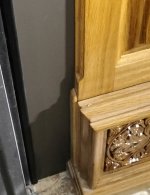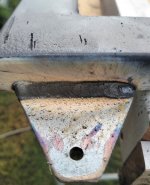luvmytoolz
Member
Hi all, had an interesting thing happen last night that reinforced to me the need to be vigilant when machining. I've been routing some corian outside as I can't swing a cat in my shed, and it was covering the ground with the shavings thrown everywhere. Last night the cutter nicked a screw and threw a couple of sparks which ignited a bit of the shavings on the ground.
I was quite amazed a couple of sparks would ignite it so easily so I let it go as I was curious to see what would happen, it continued to smoulder and slowly burn it's way across the waste, and 30 minutes later it was still going!
The grounds wet as we're in the middle of winter, and it was late so the dampness was well and truly setting in, I can only imagine how bad this could have been in a dry shed if i wasn't aware.
[attachimg=1]
I was quite amazed a couple of sparks would ignite it so easily so I let it go as I was curious to see what would happen, it continued to smoulder and slowly burn it's way across the waste, and 30 minutes later it was still going!
The grounds wet as we're in the middle of winter, and it was late so the dampness was well and truly setting in, I can only imagine how bad this could have been in a dry shed if i wasn't aware.
[attachimg=1]




